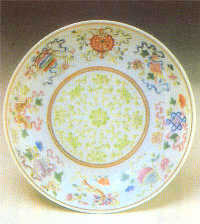For over 2,000 years, Jingdezhen was known as "the porcelain capital" of the world. The City of Jingdezhen in East China'sJiangxi Province, which was called Xinping in ancient times, began to make porcelain as early as 200BC in theHan Dynasty(206BC-AD220). During the reign of Emperor Jingde (1004-1007) of the Song Dynasty (960-1279), all of the products made here bore the royal Jingde mark, and the name of the city was therefore changed to Jingdezhen (Jingde Town).
For centuries, the city was considered as China's most important center for porcelain production. Here,ceramicswere produced as far back as the Han Dynasty (206-220BC). The imperial porcelain was so exquisite that it was described as being "as white asjade, as bright as a mirror, as thin aspaper, with a sound as clear as a bell".
Today, Jingdezhen remains a national center for porcelain production. The most famous types of porcelain from Jingdezhen arefamille-rose porcelain,linglongporcelain, blue-white porcelain and color-glazed porcelain.
Famille-rose porcelain, so called its pink enamel, first came into being during theYongzhengreign (1723-1735) in theQing Dynasty(1644-1911) and continued to be made throughout theQianlongreign (1736-1795) and beyond. Main materials and techniques used to make the porcelain were all introduced from abroad in the beginning.
When makingfamille-rose porcelain, craftsmen fired glass whiteness onto plain porcelain, creating patterns withChinese paintingtechniques and then baking it in a kiln.